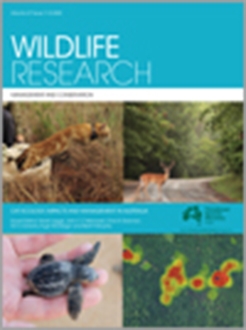Context. It is widely recognised that red foxes (Vulpes vulpes) are abundant within urban areas; however, it is difficult to apply lethal control measures using poison baits in cities because of concerns about the safety of domestic pets, particularly dogs (Canis familiaris).
Aims. We tested canid pest ejectors (CPEs) as a potential method of fox control by measuring visitation and activation behaviour of foxes and other wildlife while assessing non-target risk to domestic dogs.
Methods. We compared eight urban and eight peri-urban sites in Sydney, with half of the sites having restricted access for domestic dogs. We allocated five camera traps and ejectors per site. Through generalised linear mixed models, we compared the probability of ejector activation between foxes and dogs. We also assessed the relationship between dog visitation and distance to habitation and dog restrictions as measures of dog safety.
Key results. Both species of canids were equally likely to pull the ejector (P = 0.26). As expected, dog visitation was significantly lower in sites with dog restrictions (P < 0.001). However, it was not related to distance from habitation. Only two non-canid species were recorded pulling the ejector, suggesting high target-specificity for canids.
Conclusions. In sites with dog restrictions, the risk of dog casualties from CPEs is minimal. However, distance from habitation does not increase dog safety, at least within 250 m. The ejector is highly specific for canids.
Implications. We provide specific recommendations for the design of a potential fox control program using CPEs in urban and peri-urban areas. The ejector may be a safe method for fox control in cities when deployed at places without domestic dogs.






